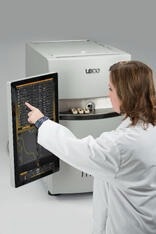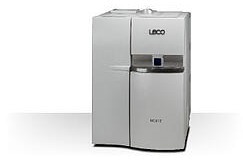Carbon is an essential building block of life on Earth. When it comes to soil and agriculture, the amount of carbon present is an essential factor, as carbon levels can help determine soil quality or the location of natural hydrocarbon fossil fuel deposits that may affect the quality of raw building materials.

Image Credit: LECO Corporation
Total Organic Carbon (TOC) determination is an effective technique that helps determine these levels. LECO’s portfolio includes several instruments that can help determine TOC in different ways.
Acid digestion is the most commonly used method for determining total organic carbon content. Treating the sample with acids like hydrochloric acid causes a reaction with inorganic carbonates, but the acid does not react much with organic carbon in the sample.
Inorganic carbonates effervesce as CO2 when subjected to acids, and both the acid-treated and non-acid-treated samples are compared and analyzed for carbon content.
The carbon content in the untreated sample is the total carbon content, whereas, in the treated sample, it is the remaining carbon content. The difference between these two figures is the sample’s total inorganic carbon content. Thus, a sample’s total organic carbon content can be determined by calculating the difference.
A resistance furnace acid such as LECO’s C832 can be used to analyze samples for their carbon content. The C832 uses a pure oxygen environment to oxidize the samples, converting the carbon to CO2 gas.
The CO2 is swept through the instrument’s reagents and carried to a non-dispersive infrared (NDIR) detection cell, where the infrared absorbance of CO2 is measured and converted to a carbon concentration based on the initial sample mass, determining total organic carbon and inorganic carbon content.
Another approach for determining total organic carbon content is the temperature-dependent method. A main advantage of this method is that it does not require any sample pretreatment.

Image Credit: LECO Corporation
Organic carbon and inorganic carbon combust at different temperatures. Organic carbon combusts between 150 °C and 450 °C, whereas inorganic carbon combusts at much higher temperatures, around 1000 °C.
The RC612 resistance furnace multiphase carbon and moisture determinator performs this analysis by using a two-step temperature ramping at 450 °C and 1,000 °C without any acid pretreatment of the samples.
Similar to the C832, the CO2 gases are swept through to an NDIR at 450 °C and again at 1,000 °C to determine the samples’ total organic carbon and total inorganic carbon content.
While both the C832 and RC612 produce similar results, the RC612 has a runtime of approximately an hour, whereas the C832 has a significantly shorter runtime of 90 seconds. However, sample pretreatment can take several hours, making analyzing samples with the C832 a longer process overall.

Image Credit: LECO Corporation
The two instruments are suitable for different applications, with the RC612 more suited to low-throughput labs and the C832 ideal for high-throughput applications. Samples intended for analysis by LECO’s C832 can be prepared in large batches and run through the instrument quickly.

This information has been sourced, reviewed and adapted from materials provided by LECO Corporation.
For more information on this source, please visit LECO Corporation.